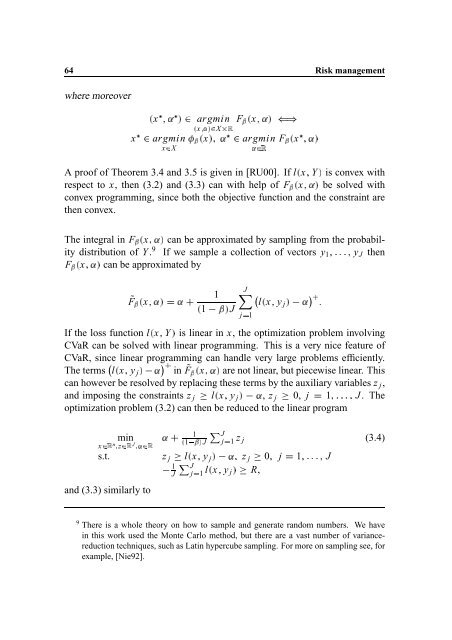Hedging Strategy and Electricity Contract Engineering - IFOR
Hedging Strategy and Electricity Contract Engineering - IFOR
Hedging Strategy and Electricity Contract Engineering - IFOR
Create successful ePaper yourself
Turn your PDF publications into a flip-book with our unique Google optimized e-Paper software.
R<br />
R<br />
M<br />
R<br />
R<br />
64 Risk management<br />
where moreover<br />
argmin<br />
argmin<br />
x† X<br />
H xg j@L † X`‰‡<br />
argmin<br />
S xŠ G?R Š V<br />
Fd S x GaRbV<br />
Fd S xŠ G?RbV<br />
xŠ<br />
U d S xV?G‹R Š<br />
†m‡ j<br />
A proof of Theorem 3.4 <strong>and</strong> 3.5 is given in [RU00]. lS If G x V Y is convex with<br />
respect to x, then (3.2) <strong>and</strong> (3.3) can with help Fd S of GaRbV x be solved with<br />
convex programming, since both the objective function <strong>and</strong> the constraint are<br />
then convex.<br />
The integral Fd S in G?RKV x can be approximated by sampling from the probability<br />
distribution of Y . 9 If we sample a collection of vectors y P?P@P<br />
G 1G y J then<br />
S x GaRbV can be approximated by<br />
Fd<br />
S 1<br />
1<br />
c V J<br />
J<br />
j… 1<br />
M P<br />
Fd S x GaRKV<br />
lS x G y jV<br />
If the loss lS function G x V Y is linear in x, the optimization problem involving<br />
CVaR can be solved with linear programming. This is a very nice feature of<br />
CVaR, since linear programming can h<strong>and</strong>le very large problems efficiently.<br />
The lS terms G x y jV Fd S in GaRKV x are not linear, but piecewise linear. This<br />
can however be resolved by replacing these terms by the auxiliary variables z j ,<br />
<strong>and</strong> imposing the constraints z j x G y jV R , z lS j 0, 1G<br />
P?P@P<br />
G j J. The<br />
optimization problem (3.2) can then be reduced to the linear program<br />
min<br />
1<br />
n g z†ˆ‡<br />
J g j †m‡ H 1I d L J j… 1 z j<br />
x†m‡<br />
s.t. z j x G y jV RŒG z lS j j 1G 0G<br />
1<br />
J<br />
J<br />
J<br />
j… 1 lS x G y jV R,<br />
P?P@P<br />
G J<br />
(3.4)<br />
<strong>and</strong> (3.3) similarly to<br />
9 There is a whole theory on how to sample <strong>and</strong> generate r<strong>and</strong>om numbers. We have<br />
in this work used the Monte Carlo method, but there are a vast number of variancereduction<br />
techniques, such as Latin hypercube sampling. For more on sampling see, for<br />
example, [Nie92].
















